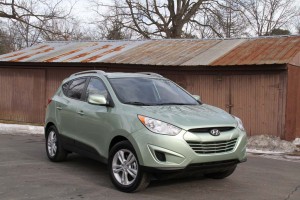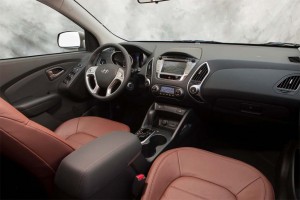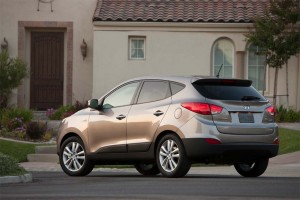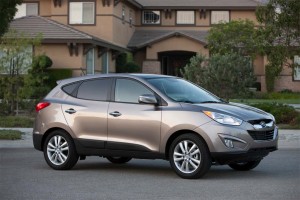
Longer, wider - and lighter, the 2010 Hyundai Tucson is also more fuel-efficient than the outgoing model.
It wasn’t all that long ago that Korean-made products lagged low on the list of models automotive journalists sought to review. And they weren’t held in all that much higher esteem by the motoring public. But anyone who still thinks of cars like the Pony when the name, Hyundai, is spoken, is in need of some reeducation, and a simple way to do that is to spend a little time behind the wheel of the 2010 Hyundai Tucson.
To be blunt, there wasn’t all that much to like about the original, 2005 edition. It was the sort of product about which kinder critics will use the phrase, “cheap-and-cheerful.” Not so now. The latest generation of the Korean carmaker’s entry-level crossover maintains the positive value story of early Hyundai products pitched on price alone. But the ’10 Tucson is a surprisingly attractive, solidly built and well-equipped offering that should give some of the better-known entries in the segment, like Toyota’s RAV4, a real run for the money.
Like most of its competitors, Hyundai has moved away from traditional truck-like SUV design. The 2010 Hyundai Tucson has a sweeping, graceful appearance that reflects what the maker dubs its new “Fluidic Sculpture” language. There are a number of nice details and, thankfully, the Korean maker’s stylists avoided buling up with too many of the lines and creases that seem to be de rigeur in today’s automotive world.
Some of the Tucson’s nicest exterior details are head and taillamps that flow into the rest of the body. Meanwhile, the hood itself sweeps upwards into a windshield far more raked than one might expect on an SUV or CUV. The tapered roof line is completed by a functional spoiler that, Hyundai claims, actually does have a small but measurable impact on mileage.
We’ve always wondered why automotive planners would put so much effort into exterior design and then leave a customer with a chintzy cabin festooned with hard plastic bits that didn’t quite go together. That, at least, might have been a complaint about the old Hyundai CUV, but there’ve been some pleasant improvements made to the 2010 Tucson.
Starting at less than $20,000 for a base, front-drive GLS, the 2010 Hyundai Tucson is an entry-level vehicle, and the efforts of the cost patrol aren’t entirely invisible. But while there’s still a fair bit of hard plastic, there also are some nice touches, like a padded elbow res, and a center console that’s both attractive and functional, with good cupholders and useful storage.
A moment to praise the optional leather seats. Make that “leathers,” if you will, for Hyundai has grafted onto them two different grades of cowhide, a smooth finish for easily sliding in and out of the seats, and a rougher grade for thighs and shoulders, to hold you in place during hard maneuvering.
The cabin is also a wee bit more roomy, reflecting the fact that the 2010 Hyundai Tucson is a full three inches longer, one inch wider and an inch taller than the old model. Careful engineering made sure most of that went into the interior.
With a vehicle like this likely to bring in young, first-time CUV buyers, Hyundai has wisely put an emphasis on infotainment. Even the base car gets a nice, 160-watt, 6-speaker audio system with standard iPod and USB connectors, as well as standard satellite radio. The upgrade, if you opt for the $1,400 Navi package adds not only navigation – with real-time traffic alerts, but 360 watts of audio fed into seven speakers and a sub-woofer. The Navi screen is a reasonable large 6.5-inch display, by the way, and it uses a fast flash memory database.
One of the most striking shifts in the low-end market has been the emphasis on safety technology. Not all that long ago, vehicles like Tucson might have foregone even ABS brakes in order to hold down costs. Not now. The 2010 Hyundai Tucson includes not only anti-lock brakes and traction control, but also electronic stability control – and six airbags, with a rollover function, as well as front pretensioner seatbelts.
The list goes on. The maker has also thrown in Downhill Brake Control, designed to prevent a car from racing out of control on a steep incline, as well as Hill Start Assist, which means you won’t slide backwards lifting your foot off the brake when trying to nose up a steep hill. The Tucson, claims Hyundai, is the first vehicle under $20,000 (base) to get that feature.
A front-driver at heart, the 2010 Hyundai Tucson is also available with a new all-wheel-drive option. In normal conditions, 99% of the torque goes to the front wheels. Under slick conditions, the rear rubber can get as much as 50% of the torque.
And speaking of torque, the base engine is reasonably good at making it. The 2.4-liter Theta II inline-4 turns out 168 pound-feet and 176 horsepower. That’s second in class to Honda’s CR-V, but with the new Hyundai down about 70 pounds in its new skin – to 3,179 pounds — the lighter Tucson makes a bit better use of the engine’s output.
The Theta II is equipped, stock, with a 6-speed manual gearbox that can deliver 23 mpg City and a best-in-class 31 mpg Highway. There’s an optional 6-speed automatic. And the Korean carmaker promises to bring in a turbocharged version of the I-4 for 2012 for those who still want a bit more performance.
We missed the so-called “long lead” intro that Hyundai staged in Los Angeles, recently, but that gave us a chance to experience what were the more demanding roads of a Michigan winter, Hyundai handing us the keys and setting us loose about an hour’s drive west of Detroit where there actually are some serious twists, turns and elevation changes, never mind plenty of snow and broken asphalt.
According to Mike Nino, the product planning manager for the 2010 Hyundai Tucson, the new CUV has been significantly stiffened, and the numbers, if you’re into such things, are impressive. But for most folks, what will matter is the way the new crossover behaves on the highways and byways. And that’s surprisingly well. There’s very little jounce and only a modest amount of body roll permitted by the front independent MacPherson strut suspension and the rear independent multilink design.
While plenty of crossovers claim SUV roots, the 2010 Tucson feels more like it had a sport sedan somewhere back in its lineage. The new CUV is light, nimble and, if anything, you may find it gets you into and out of corners a bit faster than you might expect.
Of course, there’s also an economy car in the family tree, so as we mentioned earlier, the base GLS starting at just $18,995, plus $795 destination fee. That’s about $400 less than a comparable Nissan Rogue and nearly $1,500 under the Honda CRV. If you prefer to load the 2010 Hyundai Tucson up, you’ll hit a wall at $28,995 for a loaded Limited AWD, which is about $2,000 under the Honda, and $1,470 under the Nissan.
It’s nice to know that Hyundai, which has been delivering some very pleasant surprises, of late, continues to stick with a strategy of undercutting the price of the competition. And that makes for a very positive equation for both reviewers and potential customers alike. This is one Hyundai that’s a delight to review. And we’re betting there’ll be plenty of folks who’ll feel the same about buying one.





Good story Paul, still hate the fact that the trade situation w/South Korea remains so skewed. Why does the the UAW remain so silent on this incredibly unfair trade practice? An 80% tariff on our cars over there (at least that seems to be the figure in my head). I had opened this discussion with another one of your editors a couple of months ago. Yes, the cars are cool, and come at a great price–but at the expense of free trade and perhaps jobs.